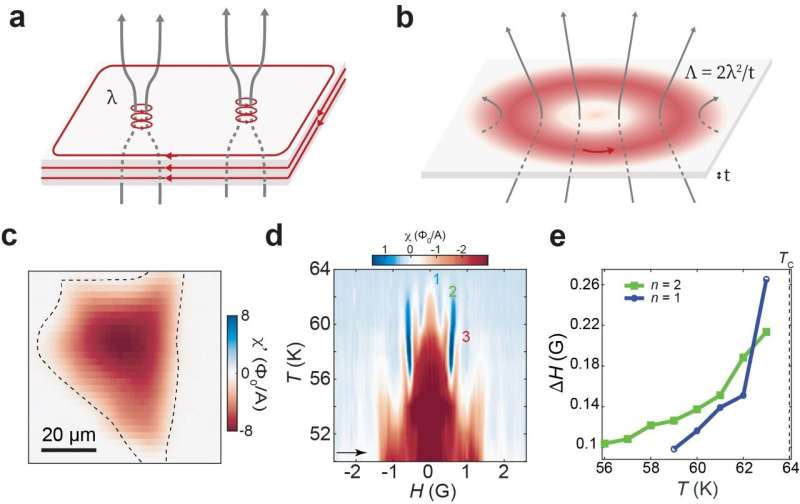This article has been reviewed according to Science X's editorial process and policies. Editors have highlighted the following attributes while ensuring the content's credibility:
fact-checked
trusted source
proofread
Utilizing scanning SQUID microscopy to investigate local magnetic response of Bi2212

Phase transitions in different states of matter, such as the condensation of gases into liquids or the transition from a normal metal to a superconducting state, can be described using Ginzburg-Landau symmetry-breaking theory. However, such a theory is no longer valid for phase transitions in the two-dimensional limit.
Two-dimensional phase transitions are driven by topological defects known as Berezinskii-Kosterlitz-Thouless (BKT) phase transitions (Kosterlitz and Thouless were awarded the Nobel Prize in Physics in 2016 for this discovery). Topological defects in superconducting systems are called vortices. For an infinitely large two-dimensional superconducting system at low temperature, vortex-antivortex pairs with opposite vorticity are bound together and the system is in a stable superconducting state.
As the temperature increases, the vortex-antivortex pairs become unstable due to thermal fluctuations, and the attraction between vortex and antivortex within the pairs gradually weakens until they separate into free vortices and antivortices. This process leads to the BKT phase transition.
The smoking gun signature of this transition is a jump in the superfluid density at the transition temperature. However, the characteristic size of vortices in the two-dimensional limit is significantly larger than that in the three-dimensional space. When the sample size approaches the characteristic size of the vortices (or when the sample has inhomogeneities), it will smear out the jump in the superfluid density. This makes it very challenging to determine the BKT phase transition in two-dimensional superconductors in realistic samples.
Cuprate high-temperature superconductors, such as Bi2Sr2CaCu2O8+δ (Bi2212), with a layered structure, have been extensively studied as unconventional superconductors. The connection between charge correlations and superconductivity in these materials remains a major puzzle in condensed matter physics. Monolayer Bi2212 was successfully fabricated recently. But conventional measurement techniques have not detected any sign of the BKT phase transition of this two-dimensional superconductor.
Instead, the monolayer exhibits characteristics very similar to those in the bulk materials, including transition temperature, pseudogap, charge density wave, and so forth. This further mystifies the relationship between superconducting phase transitions and charge correlation in this system.
Therefore, the search for evidence for the BKT phase transition in monolayer Bi2212 and clarification of the differences and connections between superconducting phase transitions across dimensionality are important for understanding this material.
Fudan University's Department of Physics, in collaboration with the research teams led by Professors Yihua Wang, Yuanbo Zhang, and Yang Qi, utilized scanning SQUID microscopy to investigate the local magnetic response of Bi2212 from monolayers to thick layers through the superconducting phase transition. In monolayers, a positive paramagnetic peak in the magnetization appears within the temperature range below the critical temperature, and the peak position oscillates with the magnetic flux passing through the sample in units of the flux quantum.
This phenomenon, known as the paramagnetic Meissner effect, occurs in the superconducting state exhibiting the Meissner effect. Furthermore, they found that the width of the paramagnetic peak increases with temperature, persisting until the transition temperature. These features indicate stable phase coherence in the critical region and a gradually increasing plasma screening effect due to the separation of vortex-antivortex pairs, consistent with the Berezinskii-Kosterlitz-Thouless (BKT) phase transition induced by vortex excitations.
The appearance of paramagnetic susceptibility peaks in multilayer and thick-layer Bi2212 suggests that the superconducting transition of underdoped Bi2212 is a generalized BKT transition with interlayer coupling. This result not only identifies an important magnetic feature of the BKT transition in finite systems but also clarifies the homologous relationship between the superconducting transitions of monolayer and bulk Bi2212, providing clues for understanding the pseudogap in the underdoped region of cuprate superconductors.
This work is published in the National Science Review under the title "Oscillating paramagnetic Meissner effect and Berezinskii-Kosterlitz-Thouless transition in underdoped Bi2Sr2CaCu2O8+δ".
More information: Shiyuan Wang et al, Oscillating paramagnetic Meissner effect and Berezinskii-Kosterlitz-Thouless transition in underdoped Bi2Sr2CaCu2O8+δ, National Science Review (2023). DOI: 10.1093/nsr/nwad249
Provided by Science China Press





















